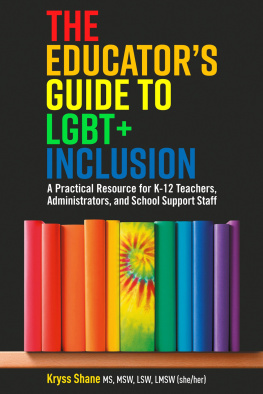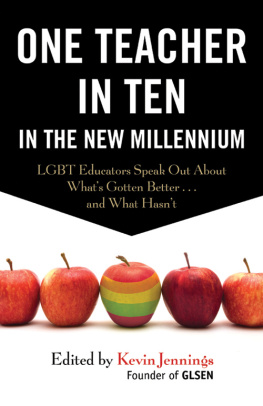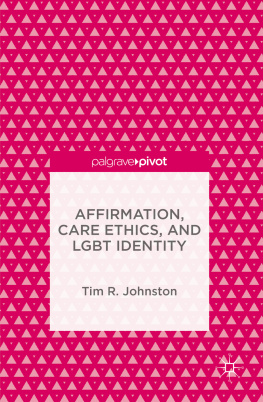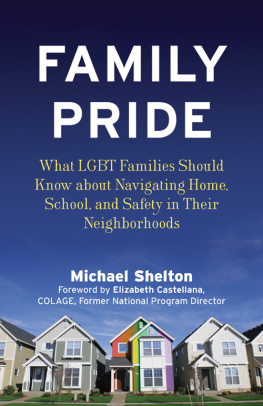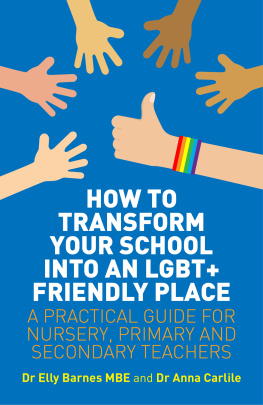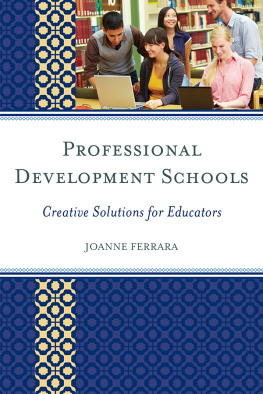Contents

The Educators
Guide to LGBT+
Inclusion
A Practical Resource for K12 Teachers,
Administrators, and School Support Staff
Kryss Shane, MS, MSW, LSW, LMSW (she/her)
Foreword contributed by PostSecret
Afterword by James Lecesne,
Co-founder of The Trevor Project

Contents
How Big of a
Problem Is This?
Too often, people fear trying to start a conversation or intervene against negativity. This is not because they do not care or because they do not see the value in improving education and knowledge; it is because they fear saying or doing the wrong thing. However, doing and saying nothing implies agreement or consent with anti-LGBT+ behaviors and policies.
What is life currently like for most LGBT+ youth? According to studies from 20172019:
LGBT+ students are twice as likely to be to be bullied, both online and on school property.
Almost 30 percent had attempted suicidemore than four times the rate for non-LGBT+ students.
77 percent of LGBT+ teens report feeling depressed within the past week.
95 percent of LGBT+ youth report having trouble sleeping.
89 percent of LGBT+ youth of color report that their racial or ethnic group is regarded negatively at school.
Only 26 percent say they always feel safe at school.
Nearly 18 percent of LGBT+ students reported having been raped at some point in their livesmore than three times the rate of non-LGBT+ students.
About two-thirds of LGBT+ students reported having been sexually harassed (e.g. sexual remarks made, being touched inappropriately) in school in the past year.
LGBT+ youth are more than twice as likely to stay home from school to avoid violence they feel might befall them on the way there, or on school grounds.
Only 5 percent say that their schools staff are fully supportive of LGBT+ people.
Now that we see the impact of what happens when silence prevails, it is clear that speaking up is necessary to protect LGBT+ people in school settings. As for knowing what to do, this book will guide you through the process so that you will feel confident in ascertaining problematic situations and policies, knowing who to speak with to make corrections, and knowing how to speak up in support of LGBT+ safety, security, and inclusion in your school setting.
These statistics include information gathered and verified by the consistent results of surveys and questionnaires completed by American LGBT+ youth via studies through the following organizations: The Trevor Project; Gay, Lesbian and Straight Education Network (GLSEN); Human Rights Campaign (HRC); Gay & Lesbian Alliance Against Defamation (GLAAD); the National LGBTQ Task Force; and the American Governments Youth Risk Behavior Survey.
Preface
This book was not created to push a political agenda, to turn current school systems on their heads, or to undermine learning experiences currently being provided throughout America. Instead, this book aims to enlighten the reader and encourage them to consider the ways that small additions or changes to existing lesson plans and school policies may further benefit their students academically, socially, and emotionally.
Your personal beliefs about the lesbian, gay, bisexual, and transgender (LGBT+) community are your own. While I cannot guarantee you wont reconsider them by the time youve completed this book, please know that it is not my goal to focus on those beliefs. In your personal lives, it is, of course, your prerogative to make choices that best align with your personal beliefs. However, this book focuses on choices, behaviors, and actions taken within the school environment while in the role of an educator.
Some question whether the idea of gay students is new. It can seem as if people are constantly inventing new words to identify their sexuality and gender, making it easy to wonder if this is just some silly way that some adolescents are attempting to make themselves seem more exciting and unique. It stands to reason then that these attempts should not lead to any alterations within the school situation. Some believe that even acknowledging any of these terms only feeds an adolescents desire to create new terms and new words to stand out more and more from their peers. Others question why there seem to be so many transgender people all of a sudden. Many talk about how no one identified as such in past decades or in previous generations. In both situations, the answer is twofold. There were not many opportunities for people to live as openly as they do now, when it is becoming safer in many states and many countries to publicly identify as something other than a societys typical expected identity options.
In addition, technology has also played a part. In past generations, one person may have felt a certain way and thought they were the only one in the whole world with those thoughts and feelings. Now, because of social media, there are additional opportunities for people to publish and self-publish their experiences, and because people are more easily able to connect to those they identify with, that one person no longer feels they are the only one in the world. Instead, they can hop on a computer or use a browser on their smartphone to connect with others in other communities across the globe who are just like them. Often, this experience allows for a significant amount of validation for the individual who previously thought they were all alone and that the lack of peers sharing this experience meant that their feelings must be wrong and this indicated that something must be wrong with them. This resulted in many around the world feeling lonely, lost, broken, and unworthy. It is easy to see how a person with this belief could experience depression and why so many attempted or committed suicide.
As the saying goes, theres safety in numbers. This is true with sexual and gender minorities as well. Now, support groups and friendship groups exist on social media, which bring people together from all over the world who would never have otherwise met but among whom shared feelings and identities exist. Simultaneously, video-sharing platforms allow individuals to document their life experiences and personal journeys, which can bring comfort in better understanding to viewers, regardless of whether they feel validated within their own communities, schools, and families.
This book is not about whether there are gay people, whether transgender people are a real thing, or whether there should or should not be dozens of terms people use to self-identify their place in the world. The reality is that there are gay people, there are transgender people, and there are people who self-identify using terms that may be unfamiliar to others. This then leads us to consider whether adults should acknowledge these differences, especially if the adult may believe a student is using a word or term solely for attention. Some may even question how anyone should be expected or required to acknowledge these proclaimed differences, as they may remember that not long ago mental health diagnostic manuals considered homosexuality and transgender identity to be mental illnesses. However, every major mental health organization has spoken out in support and acceptance of LGBT+ people for decades, using research and science to buttress their position that sexual orientation and gender identity are a healthy part of who a person is, not a mental health issue that requires fixing.

